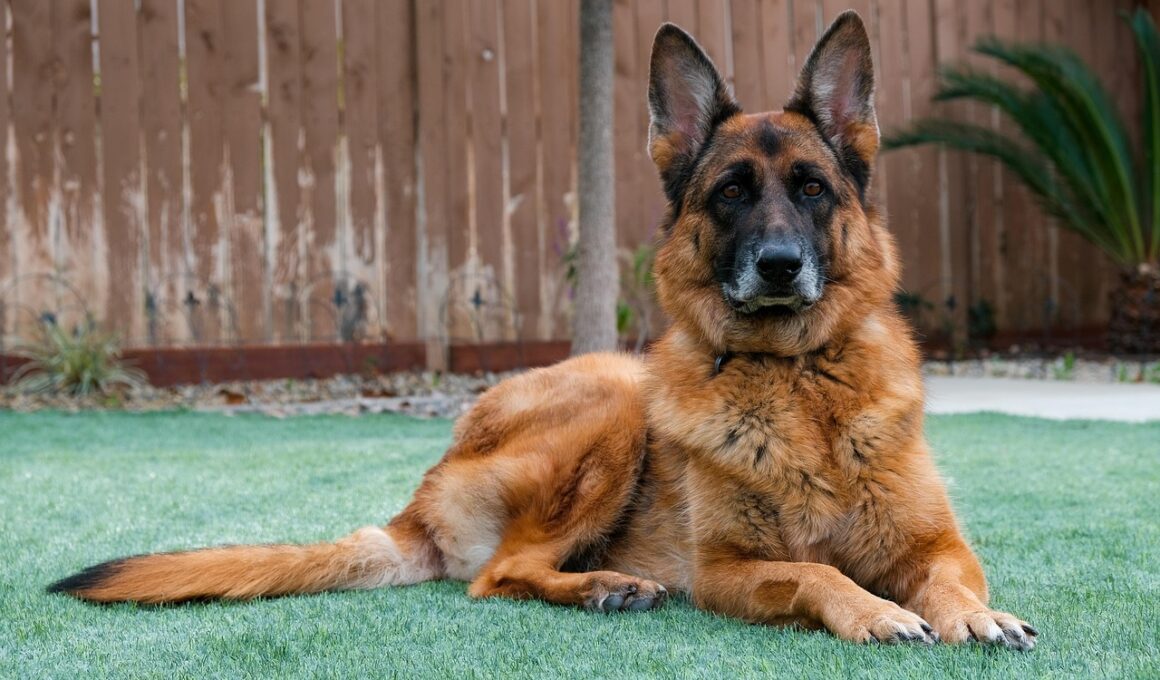Step-by-Step Training Plan to Reduce Resource Guarding in Dogs
Resource guarding can be a serious issue among dogs, leading to aggression and anxiety. It’s essential to understand the underlying causes of this behavior before starting training. Many dogs guard items due to fear of losing them, often stemming from their past experiences. Assess your dog’s environment and identify the triggers that lead to this guarding behavior. Common triggers include toys, food, or even space. Gradually introducing positive reinforcement methods during training sessions can significantly help in reducing this behavior. For example, using treats can ease the dog’s anxiety regarding resource sharing. Ensuring that your dog feels secure will improve the training process greatly. Remember that training should be consistent and positive to yield the best results. Make note of your dog’s reactions and adjust your training accordingly. This helps in establishing trust between you and your dog. Overall, patience is necessary; ensuring gradual exposure can create a more comfortable atmosphere for your dog, thereby decreasing anxiety levels. Please understand that every dog is unique, and the training pace will vary. Proceed at a comfortable speed for your dog to maximize success.
Understanding Resource Guarding in Dogs
Understanding resource guarding is crucial for responsible dog ownership. This behavior can encompass guarding food, toys, or even their sleeping spots, which can lead to growling or aggressive behavior when approached. Initially, it’s important to observe your dog’s body language. Signs of stress or discomfort signal that your dog may be feeling threatened when others approach their resources. They might tense up, lip-lift, or even snap if they are truly threatened. Recognizing these signs allows you to intervene before situations escalate. You may consider enlisting a professional dog trainer or veterinarian specializing in behavior for advanced insights. Additionally, avoid punishment as it could worsen the behavior. Instead, promote positive exchanges and reinforce good behavior. Introducing controlled scenarios where your dog can learn to share their resources safely can be effective. Work on reducing the value of said resources through gradual exposure and reward systems. Providing a calm and secure environment can also play an essential role in their comfort level. Always bear in mind that your dog’s physical and emotional well-being directly impacts their guarding behaviors.
Starting the training plan requires patience and consistency. Begin by establishing a routine that incorporates resource-sharing exercises in a calm environment. Choose a low-key setting where distractions are minimal to facilitate the learning process. Introduce the concept of trading valuable resources for even better rewards. For example, give a treat when your dog has their toy, effectively trading one item for an even tastier alternative. This encourages your dog to appreciate sharing. Making training fun helps maintain their interest and focus as well. Gradually, many dogs can be taught that sharing will provide more enjoyable experiences. Initially, keeping interactions short can help the dog feel less stressed about losing its resource. Over time, extend the sharing duration as the dog becomes more comfortable. Consistent positive reinforcement will solidify this new behavior. As training progresses, fluctuating the types of rewards can keep your dog engaged, making learning a delightful experience. Explore various rewards based on what excites your dog, ensuring that training is always a fun and enjoyable activity. This leads to quicker acceptance of sharing conditioned behaviors, reducing the urge to guard.
Managing Reactions during Training
Maintaining a calm and controlled atmosphere during training sessions is crucial for proper learning. The presence of other pets or people may increase your dog’s anxiety levels, leading to unwanted reactions. Always plan training sessions in a quiet space where your dog feels secure. If your dog reacts negatively during practice, ensure you back off to avoid reinforcing the negative behavior. Setting up controlled interactions will help you manage any threatening situations effectively. Introduce gradual exposure to the resources while closely monitoring their reactions. If your dog shows signs of guarding, returning to a safe distance may help them relax. Utilize physical barriers like gates when working with multiple dogs to prevent distractions and ensure focus. Additionally, rewarding alternative behaviors, such as sitting calmly near a resource, can reinforce desirable traits. Ensuring that the training process is structured will aid in building trust between you and your dog. Celebrate small victories with positive reinforcement, keeping the mood light and encouraging. It’s vital that your dog associates resource-sharing with enjoyable experiences, which will encourage their willingness to share over time.
Implementing desensitization techniques provides an effective approach to reducing resource guarding behavior. These techniques aim at gradually exposing your dog to their triggers without any negative repercussions. Start at a distance that your dog finds comfortable. For instance, if they are guarding their food bowl, you could toss treats outside the bowl while your dog is at a comfortable distance. Gradually decrease the distance over time to help them adjust. It teaches your dog to associate the presence of other people or pets-in-proximity with positive outcomes. Prioritize comfort during desensitization to avoid overwhelming your dog. Please make sure not to rush the process as it can lead to increased anxiety. Understand their limits and proceed cautiously to develop trust. Aim at constantly encouraging desirable behavior through rewards when they handle new situations, teaching them patience to wait for positive reinforcement. Documenting progress can also help evaluate the effectiveness of training strategies over time. Maybe use notes or charts for tracking behavior improvement, which can keep you motivated and provide insights into what works best for your dog.
Maintaining Progress and Sustainability
Consistency is key in ensuring continued success in reducing resource guarding behaviors. Implementing a regular schedule that includes daily exercises focused on resource sharing can yield sustainable outcomes. Reinforce good habits consistently, as this creates an expectation for your dog. Revisit prior training techniques regularly to maintain their progress. Setting realistic goals and not overwhelming your dog is essential, allowing flexibility in achieving these objectives. In addition, encourage interactions with other well-behaved pets or dogs that encourage positive resource-sharing behavior. Regular socialization not only allows practice of sharing techniques but also reinforces relational skills. Evaluate the setting for any potential triggers that may revert your dog to guarding habits and adjust your approach as needed. Keep other pets in mind during training sessions and monitor their interactions. Celebrate successes regardless of how small they may seem, as this will encourage ongoing motivation for both you and your dog. Remaining patient and committed to structured training processes is necessary for long-term success in overcoming resource guarding behavior.
Lastly, seeking professional help is a wise option if making little progress over time. Consulting a behavioral specialist can provide insights that enhance training effectiveness. Behavioral specialists have extensive experience in understanding canine behavior and can tailor strategies suited to your dog’s specific needs. They can observe your dog’s reactions first-hand, assisting in crafting an appropriate training plan. This personalized approach significantly helps address unique challenges that may arise while you train. Often, specialists provide strategies and a set of tools that equip you for continued training. Regular follow-ups can reinforce the previously established behaviors and review your dog’s progress as well. Keeping an open line of communication with trainers or specialists significantly boosts confidence while navigating training. They can offer solutions and support when faced with particularly challenging situations. By combining the insights from a professional with your understanding of your dog’s behavior, you can create a comprehensive training strategy. Building a strong bond through trust combined with consistent reinforcement leads to successful behavior modification over time.


